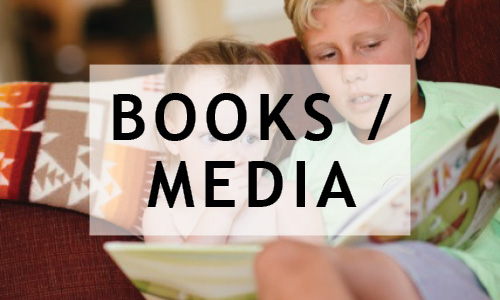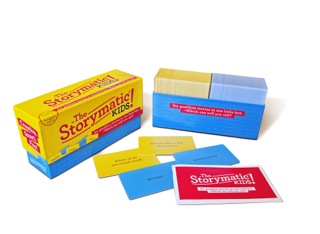 The beginning of a new school year is always exciting for students as well as educators–I still feel the thrill several years after I’ve left the public schools to start my private practice. Everything is fresh and new–paper, name tags, friends, teachers and backpacks. In keeping with a fresh start, I wanted to share some of my favorite new off-the-shelf products that can add a fun twist to your speech and language therapy sessions. Some of the toys and games are produced by large, international companies and some invented by ingenious educators and therapists who followed their dream and assembled a game in their garage:
The beginning of a new school year is always exciting for students as well as educators–I still feel the thrill several years after I’ve left the public schools to start my private practice. Everything is fresh and new–paper, name tags, friends, teachers and backpacks. In keeping with a fresh start, I wanted to share some of my favorite new off-the-shelf products that can add a fun twist to your speech and language therapy sessions. Some of the toys and games are produced by large, international companies and some invented by ingenious educators and therapists who followed their dream and assembled a game in their garage:
Storymatic Kids by The Storymatic Corporation
Originally designed as a writing prompt by a creative writing teacher in Vermont, Storymatic Kids has taken on a life of its own. Fans are using this little box of 360 idea cards to inspire many creative endeavors beyond writing including cartooning, music, film and improvisation. Start out choosing two random yellow cards to describe your character and one blue card to get the story going. Our first story cards were “grandpa,” “bookworm,” and “here comes trouble.” Kids took off with a tale about our bookworm grandpa who was getting in trouble for losing his books, while a “mistaken identity” card had him sneaking off to the skate park to stay in shape since he was a skateboard champion. “Recess,” “befriended by a hippo” and “kiss” all had to be associated with the story and woven into the theme. It could be a jump from “recess’ to “befriended by a hippo” unless you were my little friend who linked them because the zookeeper visited the school to teach about animals. This box of thoughtfully designed cards is so portable for itinerant therapists and can be used to advance speech and language skills:
- build vocabulary
- associate ideas to build a coherent story
- collaborate with classmates on storytelling or writing goals
- carryover for stuttering and articulation therapy
- teach elements of a good story–characters, setting, problem, solution (the only 2 rules for this game are that your character has to change through the story and stay alive–the inventor clearly understands kids!)
Recommended age: 5 and up. There is an older version called Storymatic although I have used the kids’ version with middle school students with language learning issues.
Feed the Woozle by Peaceable Kingdom
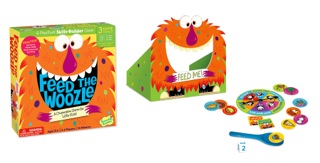 Preschoolers love this goofy, orange, furry creature wearing black high-tops with his signature “W” on them. His sign to “FEED ME” cannot be ignored as kids load up their spoon with wacky snack tokens like toenail toast or spider-egg pudding and make their way to Feed the Woozle without dropping their loot, depositing them in his wide open mouth. Three levels of cooperative play provide a perfect game for a group of kids of different ages. Three year-olds roll the die, count up the snacks to place on the spoon and walk carefully to feed the Woozle. Level 2 ups the ante for 4-5 year-olds as they use the spinner to direct how to move toward the Woozle–hula dance, bunny hop, spin, march, walk backwards or go crazy! Get out the blindfold for the third level, as you play with your eyes closed, relying on other players to verbally direct you to Woozle’s mouth. Here’s a tip–let’s hope your fellow players know right and left. I’ve used this game to:
Preschoolers love this goofy, orange, furry creature wearing black high-tops with his signature “W” on them. His sign to “FEED ME” cannot be ignored as kids load up their spoon with wacky snack tokens like toenail toast or spider-egg pudding and make their way to Feed the Woozle without dropping their loot, depositing them in his wide open mouth. Three levels of cooperative play provide a perfect game for a group of kids of different ages. Three year-olds roll the die, count up the snacks to place on the spoon and walk carefully to feed the Woozle. Level 2 ups the ante for 4-5 year-olds as they use the spinner to direct how to move toward the Woozle–hula dance, bunny hop, spin, march, walk backwards or go crazy! Get out the blindfold for the third level, as you play with your eyes closed, relying on other players to verbally direct you to Woozle’s mouth. Here’s a tip–let’s hope your fellow players know right and left. I’ve used this game to:
- improve social language with kids on the autism spectrum and their typical peers as they work together to feed the Woozle
- work on following directions during the blindfold level 3
- carryover practice for articulation
Two other great collaborative games from Peaceable Kingdom are “Seeds for the Birds” and “Race to the Treasure” where players race against an ogre which is quite motivating!
Recommended age: 3-6 years.
Jake and The Neverland Pirates Never Land Challenge by Wonder Forge
My pirate mateys loved this game as we worked as a team to complete pirate challenges and earn more gold doubloons than Captain Hook. Flip over a red and a blue doubloon to 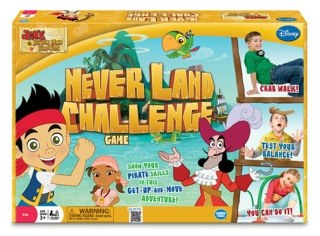 tell you the object to use, and how to use it to complete your task–“with the sword on your head, walk backwards around the vines,” or “with the cannonball under your chin, hop on one foot to the X and back.” Kids started to ask each other, “Can you do the challenge?” and their friend replied, “Yo, Ho, Let’s go!” Kids are so engrossed in the action, that they don’t realize the language learning involved to advance in the game. Tasks vary in difficulty from walking backwards to zig-zagging through the foam vines. We talk through each challenge, offering advice and laughing at the outcome as kids learn to:
tell you the object to use, and how to use it to complete your task–“with the sword on your head, walk backwards around the vines,” or “with the cannonball under your chin, hop on one foot to the X and back.” Kids started to ask each other, “Can you do the challenge?” and their friend replied, “Yo, Ho, Let’s go!” Kids are so engrossed in the action, that they don’t realize the language learning involved to advance in the game. Tasks vary in difficulty from walking backwards to zig-zagging through the foam vines. We talk through each challenge, offering advice and laughing at the outcome as kids learn to:
- Follow directions
- Collaborate
- Ask questions
- Solve problems
- Learn prepositions
Recommended age: 3 and up
FitzIt by Gamewright
Kids have such fun playing FitzIt, generating words based on multiple attribute cards 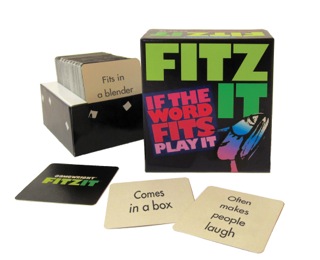 they draw. My favorite was: what is usually used for entertainment, can melt, is smaller than a golf ball and doesn’t need a plug or battery? Of course, a chocolate truffle! It is such fun to see what kids create. The next player adds to the grid, using as many of his descriptor cards to connect horizontally or vertically to a card already played and announces his word to fit. FitzIt can build vocabulary and language as it requires players to think within a category as they move from general to specific, adding additional descriptors and attributes. This little box of fun is portable speech therapy on the move.
they draw. My favorite was: what is usually used for entertainment, can melt, is smaller than a golf ball and doesn’t need a plug or battery? Of course, a chocolate truffle! It is such fun to see what kids create. The next player adds to the grid, using as many of his descriptor cards to connect horizontally or vertically to a card already played and announces his word to fit. FitzIt can build vocabulary and language as it requires players to think within a category as they move from general to specific, adding additional descriptors and attributes. This little box of fun is portable speech therapy on the move.
- Builds vocabulary
- Encourages deductive thinking
- Builds categories and association skills
Recommended age: 10 years and up
Morphology Jr. by Morphology Games
Morphology Jr. is like playing Pictionary only with objects, as the Morphologist picks a 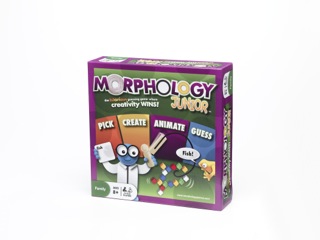 word card, gives the clue–which is associated with the target word, usually its category–and proceeds to “create” the word with 30 available props. Colored cubes, wooden shapes, string, rubber rings and glass drops can transform into a band-aid, bunk bed or a yawn. Players have to continually modify their structure to add features of the concept they are trying to convey. A wooden figure with two rectangular blocks was thought to be a bird until the Morphologist did a slow and steady take-off for an airplane. More abstract concepts like “wind,” “yell,” and “roots” required abstract thinking as the string represented the roots of a tree topped with green blocks for foliage. The kid-friendly game board is a series of lily pads, as your frog marker advances and follows the directions for various challenges including limiting the number of props available, adding sound effects (really helpful for the wind!) or becoming one of the props yourself. Kids represent a word with a series of objects, requiring them to know the essential features of the object, action or person and then guessers have to re-convert the concepts presented back to a word. Quick thinking and language processing help players identify critical differences to distinguish their word from the wrong one being guessed. What do I have to portray to show a garbage truck and not a dump truck? The discussion afterwards about how a player portrayed a word and why players guessed certain words was a helpful exercise to work on syntax, inference, or description.
word card, gives the clue–which is associated with the target word, usually its category–and proceeds to “create” the word with 30 available props. Colored cubes, wooden shapes, string, rubber rings and glass drops can transform into a band-aid, bunk bed or a yawn. Players have to continually modify their structure to add features of the concept they are trying to convey. A wooden figure with two rectangular blocks was thought to be a bird until the Morphologist did a slow and steady take-off for an airplane. More abstract concepts like “wind,” “yell,” and “roots” required abstract thinking as the string represented the roots of a tree topped with green blocks for foliage. The kid-friendly game board is a series of lily pads, as your frog marker advances and follows the directions for various challenges including limiting the number of props available, adding sound effects (really helpful for the wind!) or becoming one of the props yourself. Kids represent a word with a series of objects, requiring them to know the essential features of the object, action or person and then guessers have to re-convert the concepts presented back to a word. Quick thinking and language processing help players identify critical differences to distinguish their word from the wrong one being guessed. What do I have to portray to show a garbage truck and not a dump truck? The discussion afterwards about how a player portrayed a word and why players guessed certain words was a helpful exercise to work on syntax, inference, or description.
- Discuss similarities and differences
- Builds description, object properties
- Language processing
- Inference
Recommended age: 8 years and up
Rory’s Story Cubes- Actions by Gamewright
Roll out this newest Rory’s Story Cubes set and start your stories. Each of the 9 cubes has 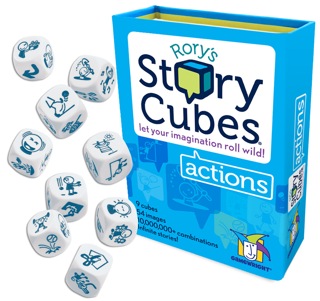 54 illustrated everyday verbs–listen, jump, draw, take, light, or press–to move the story to a new place in the plot. Similar to the original set of Rory’s Story Cubes including nouns, this set can be viewed from a concrete to more abstract perspective. I thought one figure was sleeping while another player thought he was “snooping!” Flexibility is a key value of this game as kids can tell stories solo or in a group, combine the dice with other sets, or practice verb tenses. A favorite version with my players was naming opposites as we made a tower of dice. What’s the opposite of play? Work. What’s the opposite of build? Destroy. They loved to keep going until our tower toppled! I use this set to:
54 illustrated everyday verbs–listen, jump, draw, take, light, or press–to move the story to a new place in the plot. Similar to the original set of Rory’s Story Cubes including nouns, this set can be viewed from a concrete to more abstract perspective. I thought one figure was sleeping while another player thought he was “snooping!” Flexibility is a key value of this game as kids can tell stories solo or in a group, combine the dice with other sets, or practice verb tenses. A favorite version with my players was naming opposites as we made a tower of dice. What’s the opposite of play? Work. What’s the opposite of build? Destroy. They loved to keep going until our tower toppled! I use this set to:
- Tell stories teaching the elements of a good story
- Work on verb tenses–present, past, future
- Work on opposites
- Use conjunctions
Recommended age: 8 years and up
Sound It! Found It! by Wowopolis
Kids are master noise-makers as they guess the sound source, 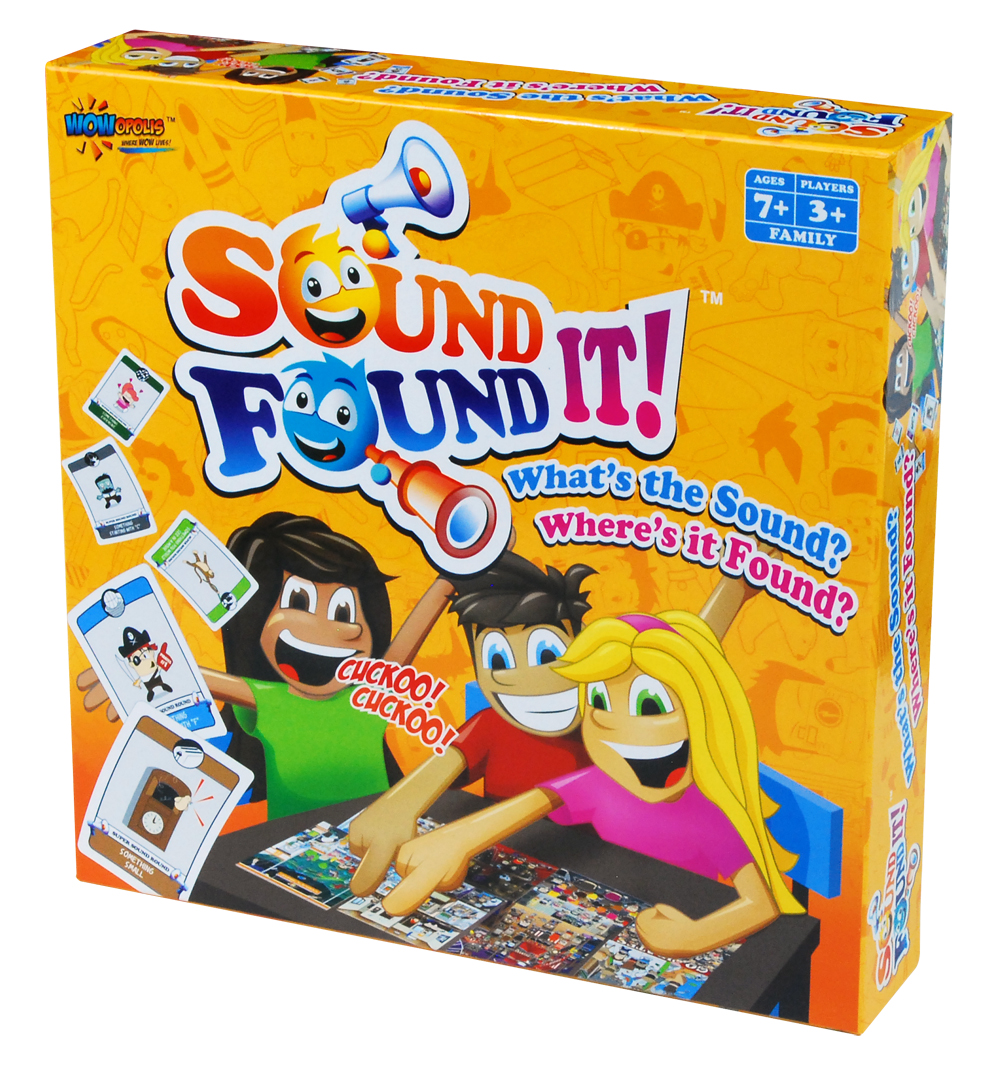 and find the image of what made the sound in a related illustration. 96 sound cards are broken into categories that match the 8 scene boards illustrating kids’ events–a basketball game, carnival, rock concert, space station, haunted house, zoo, house and classroom. A designated “Sounder” selects a card in a category, and makes the sound pictured for others to guess. The “Listeners” try to be the first to guess the sound’s source and also find it on the corresponding scene board. I heard some terrific burps, ketchup splurts and basketball whooshes. Kids need to think on many levels–interpret the picture, generate an associated sound, match the auditory sound to a visual picture, scan a packed illustration and often look for associations (looking for the frog? find the water). The inventor of this game confided in me that his wife is a speech pathologist so we know he got some great input! Help kids:
and find the image of what made the sound in a related illustration. 96 sound cards are broken into categories that match the 8 scene boards illustrating kids’ events–a basketball game, carnival, rock concert, space station, haunted house, zoo, house and classroom. A designated “Sounder” selects a card in a category, and makes the sound pictured for others to guess. The “Listeners” try to be the first to guess the sound’s source and also find it on the corresponding scene board. I heard some terrific burps, ketchup splurts and basketball whooshes. Kids need to think on many levels–interpret the picture, generate an associated sound, match the auditory sound to a visual picture, scan a packed illustration and often look for associations (looking for the frog? find the water). The inventor of this game confided in me that his wife is a speech pathologist so we know he got some great input! Help kids:
- Think in categories
- Process
- Build association skills
- Build listening skills
Recommended age: 7 years and up
The above games were provided by their companies for review and awarded the PAL Award


